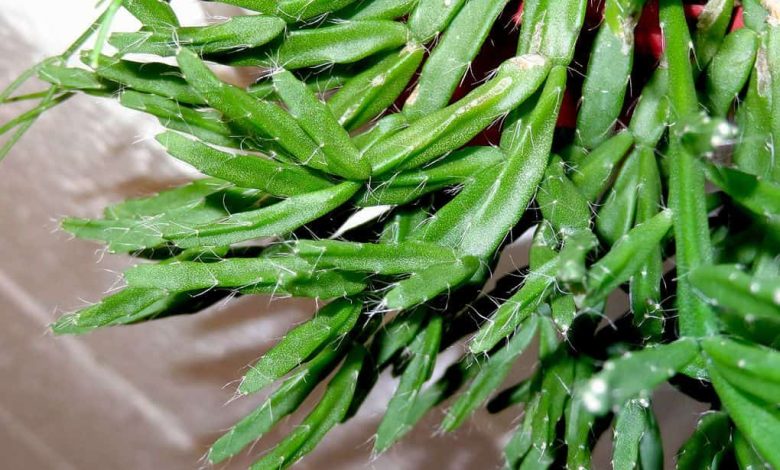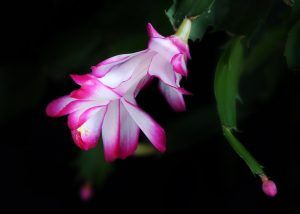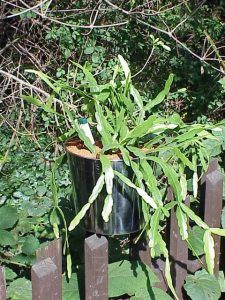Rhipsalis: [Planting, Care, Irrigation, Substrate, Pests and Diseases]

Important points when planting Rhipsalis
 When? Crops and transplants should be carried out when the flowering stage is over, at the end of spring.
When? Crops and transplants should be carried out when the flowering stage is over, at the end of spring.- Where? They need to live in warm places, which give good semi-shade. They do not support intense sun, but rather a subdued light. In pots they grow spectacularly.
- How do we prepare the land? Soil rich in nutrients, with good drainage and always moist, is the most recommended for these succulents.
- How do we sow? By cutting, in spring, from fleshy stems and by the roots of their apices, new plants will reproduce with great speed.
- How do we pay? Humus or any organic fertilizer is perfect to nourish the plant when it is growing, every 15 days. Or to the irrigation water, addcactus fertilizer.
- When do they bloom? In spring, there are varieties that sprouttiny red or pink flowers from their tips, which last about 2 months.
- Ideal temperature? Lives in temperatures from 18 to 25ºC, but must be protected from draughts, frost and dry climates. The minimum allowed is 10ºC.
- How do we water? With rainwater, totally softened, it is ideal so that they are always healthy. Let the water dry between waterings and do not pour water during the plant’s rest period.
- Diseases and pests? It gets very little plague. It is very resistant, but can eventually be attacked by slugs, mealybugs and snails.
What is Rhipsalis?
 Rhipsalis is the scientific name that identifies 35 species of epiphytic cacti, whose main characteristic is that they do not have thorns and grow on the branches or crowns of trees, in their natural or wild state. They never touch the ground.
Rhipsalis is the scientific name that identifies 35 species of epiphytic cacti, whose main characteristic is that they do not have thorns and grow on the branches or crowns of trees, in their natural or wild state. They never touch the ground.
It belongs to the family of cacti, or cacti, but does not live in deserts. It is a genus of beautiful hanging plants that inhabit the tropical and subtropical regions of the planet.
There are species exclusive to the American continent, especially in Central and South America, but they are also abundant in the Caribbean region, as well as in Africa and some islands in the Indian Ocean, where different varieties of impressively green plant waterfalls can also be seen.
Rhipsalis species and varieties
Among the most common species are Rhipsalis cassutha, Rhipsalis oblonga, Rhipsalis pilocarpa, Rhipsalis oblonga, Rhipsalis rosea, Rhipsalis puniceodiscus, Rhipsalis burchelli, among others such as Rhipsalys pachyptera and cassutha, all from tropical forests.
They are much appreciated in Holland, where they are cared for with true devotion at the Dutch Flower Office. There they have even been awarded as the best plant of the month.
In Spain it is also appreciated as an indoor plant and in the warmer areas, such as the Andalusian tropical coast and the Canary Islands, they must spend a lot of time a year under shelter at home because they do not tolerate dry environments with intense heat.
 There are varieties that form epithephal bushes with flattened stems that later become rounded. Tiny red or pink flowers sprout from their tips in the spring, lasting about 2 months.
There are varieties that form epithephal bushes with flattened stems that later become rounded. Tiny red or pink flowers sprout from their tips in the spring, lasting about 2 months.
There are species that produce translucent, white or yellow spherical berries with pink or red sparkles. They have black seeds inside.
There are also very curious varieties with cylindrical or very thick stems, others that emulate a completely disheveled hair, and there are even some that have stems that rise, protruding a very striking tangle at the top.
But most are plants with abundant branching and fleshy stems capable of storing water, because, like all cacti, they are also succulents that are very well prepared to withstand periods of drought.
Where should we plant the Rhipsalis?
 They are very noble plants, of great resistance and simple care. They adapt magnificently to hanging pots in interior spaces or in greenhouses, where their vegetable clinejas stand out all year round, as long as they have good ambient humidity.
They are very noble plants, of great resistance and simple care. They adapt magnificently to hanging pots in interior spaces or in greenhouses, where their vegetable clinejas stand out all year round, as long as they have good ambient humidity.
Although they come from tropical regions of the American continent, they can be part of hydrocultures.
On terraces, where they receive good light in partial shade, they can live for several years.
If the sun hits them directly, they turn yellowish or reddish tones that make them very ugly.
When should Rhipsalis be cultivated?
It is always convenient to make crops or transplants at the end of the flowering stage, which begins in spring and lasts about two months.
A curious fact of great botanical value is that, in May or June, the tips of its stems begin to take root, which must be used to multiply the plant, planting in peat at an average temperature of about 22ºC.
How do we prepare the land?
 If we want to keep them beautiful forever, it is necessary to prepare a high-quality substrate, because they need to live in rich, aerated or fresh and very well-drained soils.
If we want to keep them beautiful forever, it is necessary to prepare a high-quality substrate, because they need to live in rich, aerated or fresh and very well-drained soils.
A mixture that combines a third of garden soil with an equal amount of sand and heather soil is very suitable.
Another recommendation suggests that orchid substrate be placed on it.
How to plant Rhipsalis step by step?
All varieties of Rhipsalis can be reproduced very easily by cuttings, which are taken by severing the fleshy stems.
But as we have already said, this succulent plant is so noble that roots form from the tips of its stems, which must be used to the maximum because they grow quickly. Moreover, if they fall on top of another branch, a new plant can be born, provided that the environmental conditions are ideal.
Preparing them in a pot, step by step, is very simple. Let’s see, step by step, what you must do to multiply this wonderful vegetable shade.
Materials and tools
- A work table.
- A pot with substrate.
- A multi-stemmed branch with roots, still attached to the parent plant.
Step by Step
- Take the previously prepared pot with a good substrate for cacti and place the branch with roots on top of it, without separating it from the mother plant. For the roots to stick or catch, a weight must be placed on top of the bunch of stems, which is placed by pressing gently but firmly. You can use another pot or pot that is not very heavy.
- In a short time, the incipient roots of the Rhipsalis stems will grow and adhere strongly, as long as they are watered carefully, avoiding soaking the substrate.
- Place it in a semi-shaded place in your garden, with this infallible layering system that will give the best results.
- While the new plant is growing, it is convenient to pay every 15 or 20 days and do not forget that watering is done every time, only when the substrate is very dry.
by cutting
In spring, stems about 10 centimeters long can be taken, to use them as a source of reproduction, following these instructions step by step:
- Cut the cylindrical stem with garden shears previously disinfected with alcohol.
- Let the cutting wound dry, which means waiting at least 6 days.
- Prepare a pot that is at least 6 centimeters in diameter, with enough substrate and holes in its base.
- Plant the cutting in the center of the pot and water with constant sprays but without soaking the soil.
- Place in a place where there is sufficient indirect lighting, no solar insolation or you will lose the transplant.
In the wild, they reproduce when animals carry the seeds from Rhipsalis fruits that they have eaten.
What care does Rhipsalis need?
- Rhipsalis plants are very demanding. They are quite resistant and offer a show of hanging green hairs on terraces and hanging pots, in interior environments and in hydrocultures.
- They are friendly plants of semi-shade lighting, with an indirect incidence of sunlight.
- They need to live with very fertile soil, rich in humus, which is always moist.
- It also requires high environmental humidity to develop healthily.
- Irrigation, about 2 times a week, must also be administered together with a special fertilizer for cacti that will be mixed with the water (lime-free) every 15 days. But you must always let the substrate dry well, before watering again.
What pests and diseases does it have?
These hardy plants rarely get sick. They live quietly under undemanding environmental conditions in their natural state, but the great threat is the reduction of the tropical and subtropical forests of the planet, due to the logging and burning of jungle areas as important as the Amazon.
But they can be attacked by slugs and snails. Mealybugs can also visit it, so it is always convenient to avoid suffering in very hot summers, because they will tend to attract these bugs.




